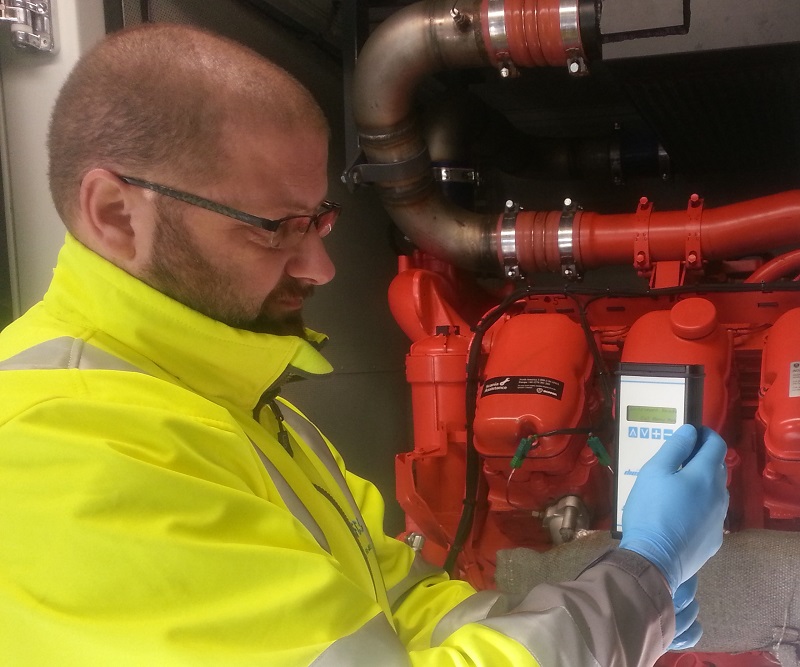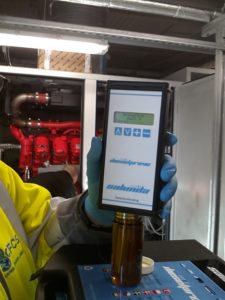
Alan Finlay of industrial monitoring specialist Salunda highlights the challenges associated with the growing use of biofuel blended fuels.
The growing use of liquid biofuels in compression ignition engines has increased the need for effective fuel testing to confirm that bio content levels remain within required limits.
With the introduction of new environmental standards and directives aimed at improving air quality, the low sulphur content and reduced CO2 and greenhouse gas emissions associated with biofuels has increased their use in a range of power generation applications.
Although many different types of biofuels can be produced from a wide variety of biomass, the term biodiesel usually refers to Fatty Acid Methyl Esthers (FAME) produced from bio-oils generated from feedstocks that include rapeseed, palm oil and soya bean.
Although 100 per cent biodiesel (B100) can be, and is, sometimes used as a fuel by itself, it is more commonly used as a blend component in conventional diesel. Biodiesel blends are therefore defined as a blend of biodiesel and conventional diesel, such that the final blended fuel will meet all the technical requirements of conventional diesel grades.
However, engine tolerance of higher levels of biofuel content in diesel blends can vary enormously. Most engine manufacturers set their own standards for liquid fuels and, while lower level blends may not require engine modifications or adjustments, the variations in fuel quality associated with some higher levels of biofuels can impair engine performance and power output.
In addition, the physical properties of biofuels can also cause damage to components so that the service life of the engine and manufacturers’ warranty conditions can be affected.
In the circumstances, to prevent potential reductions in power output and damage to engine filters, fuel injection systems and other components, specific biofuel content threshold limits are imposed for different power generation applications.
 For example, in Europe, the quality of diesel fuel for automotive applications is specified by EN 590 which describes the physical properties that all automotive diesel fuel must meet if it is to be sold in the EU and which allows the blending of up to 7 per cent FAME with conventional diesel
For example, in Europe, the quality of diesel fuel for automotive applications is specified by EN 590 which describes the physical properties that all automotive diesel fuel must meet if it is to be sold in the EU and which allows the blending of up to 7 per cent FAME with conventional diesel
In the industrial engines sector, manufacturers of gensets also set recommended biofuel limits, of typically 2 per cent, but individual users can decide to vary the standards of fuel they prefer, in some circumstances even specifying no allowable bio content even though it may be allowed by the manufacturer.
All of these considerations mean that it has become essential for users of blended diesel to be able to accurately determine the biofuel content of the fuel feedstocks they are using.
One leading company involved in this field is the UKAS-accredited Contaminated Fuel Condition Services (CFCS), which operates a fleet of mobile test laboratories to provide on-site fuel quality monitoring analysis for a wide range of applications.
CFCS carries out a range of on-site diagnostic tests to assess fuel composition and quality for a wide range of mainly non-automotive applications – and particularly for industrial and commercial customers operating stand-by emergency power generators.
Given the critical importance of biofuel content in this business critical application the company is using advanced sensor technology as a first stage screening tool to check diesel blend quality and composition.
The DieselProve test kits used by CFCS utilise patented radio frequency technology to analyse the electromagnetic properties of the material under test to detect the number of particulates present.
The electronic hand-held unit, and integral probe, provides accurate, real time in-field measurement of biodiesel content with the same accuracy as laboratory sampling methods. As well as detecting the proportion of biofuel present, other contaminants such as white spirit, petrol and water can also be detected.
Reliable and robust test results are displayed in seconds and can be downloaded to a supporting software program for formal record keeping and reporting options.
At CFCS the advanced RF sensor is used as a quick on the spot screening tool to determine whether further sample analysis is required. As well as testing against specific 0 per cent, 2 per cent and 7 per cent content limits for different applications, the company also uses the sensor system to detect less than 100 per cent biofuel content in those B100 applications where it is being used on its own.
Kevin Harrison, director of CFCS, says: “Some fuel blends can do permanent harm to engines, so accurately assessing biofuel content is a fundamental first stage requirement of assessing fuel quality.
“Blended diesel fuel quality can vary enormously and we’ve seen cases where customers have had problems with bad fuel that has caused catastrophic effects in terms of engine damage.
“Particularly for our customers operating business critical stand-by power gensets, it is imperative that they know the quality of the diesel blend they are using.
“Monitoring and assessing fuel feedstock quality is therefore essential for preventative maintenance purposes and in this respect the DieselProve unit is a very useful, easy and quick on the spot test tool.
“Simply dipping the sensor probe into a measured fuel sample gives us a reading almost immediately. If the indicated biofuel content is too close for comfort to the required threshold, then we can make further in-depth analysis using the other test techniques available in our field laboratory.
“As a result, we can assess samples quickly, identify any potential problems fast, and ensure that all analysis is completed in the shortest timescale needed. With the growing use of diesel blends, it has become essential for fuel users to verify biofuel content against permissible limits.
“As the CFCS example demonstrates, advances in RF sensor technology are providing a portable and low cost solution to meet this challenge.”
DieselProve at a Glance
• Thirty second analysis of diesel/biodiesel content
• Displays biodiesel percentage +/-1%
• Immediate identification of contaminated fuel
• Robust, hand-held enclosure – water and solvent proof
• Proprietary software to report and print out results
• Low power battery operated unit with USB interface
• Easy to clean stainless steel sensor
For further information on Salunda click here.








